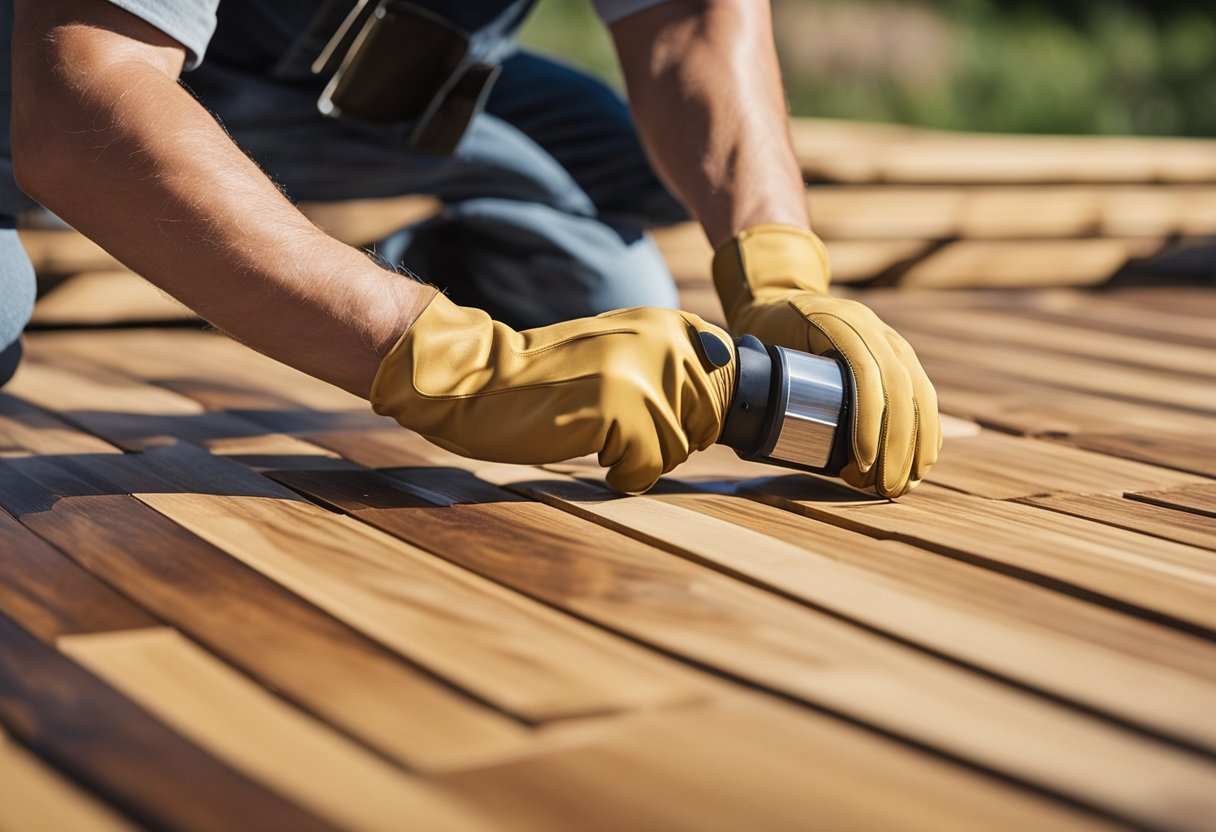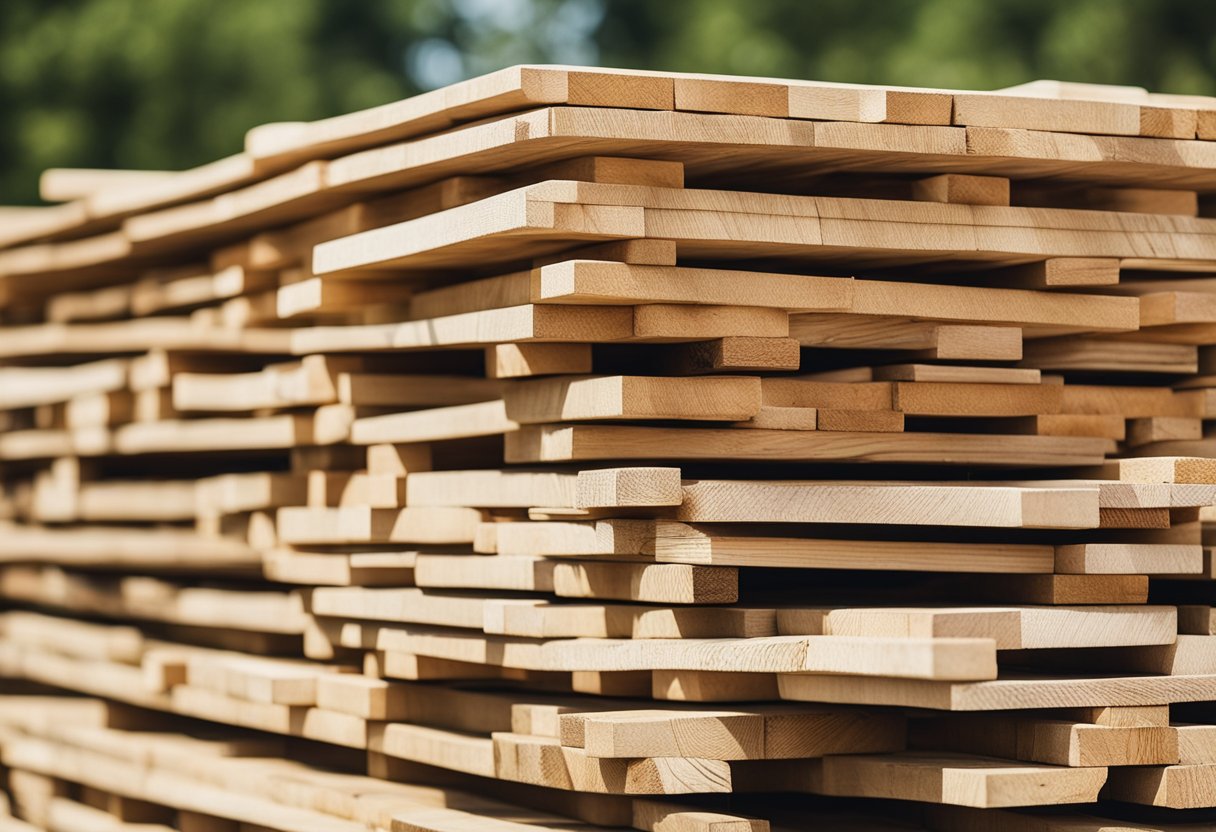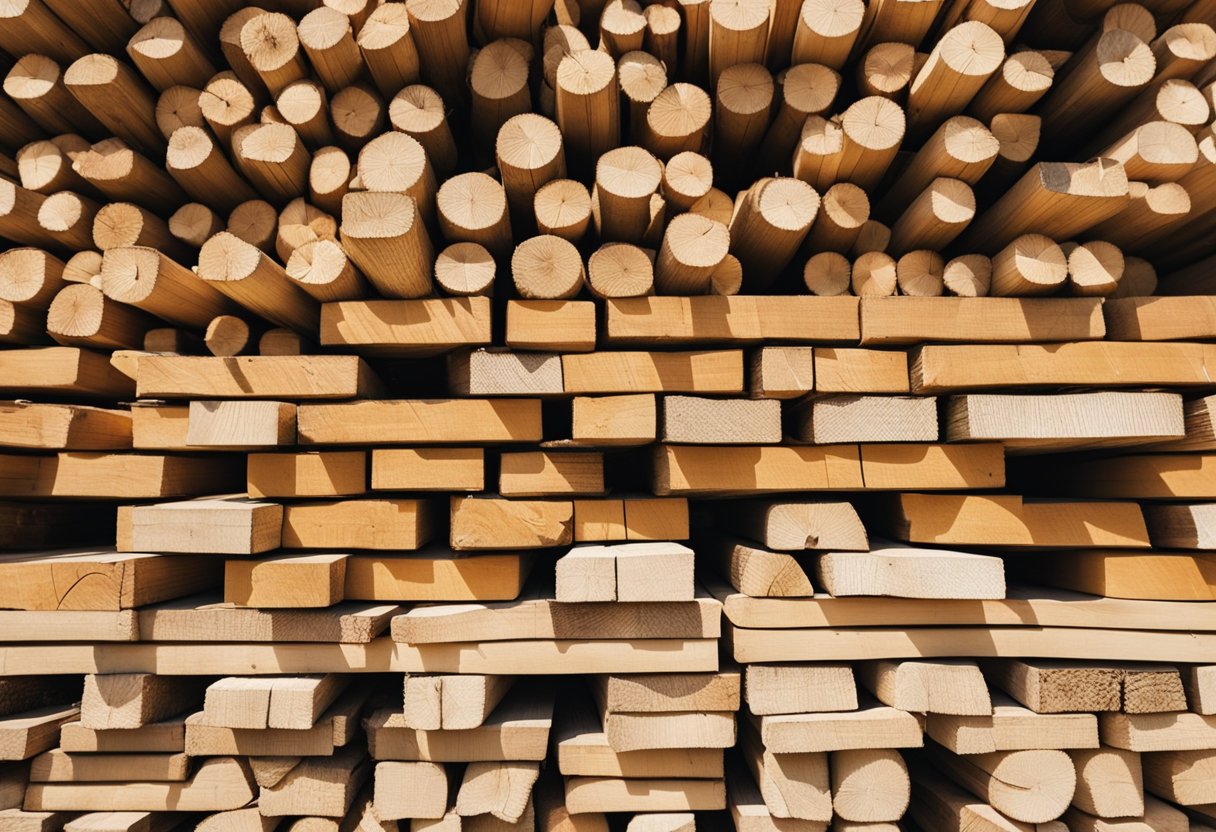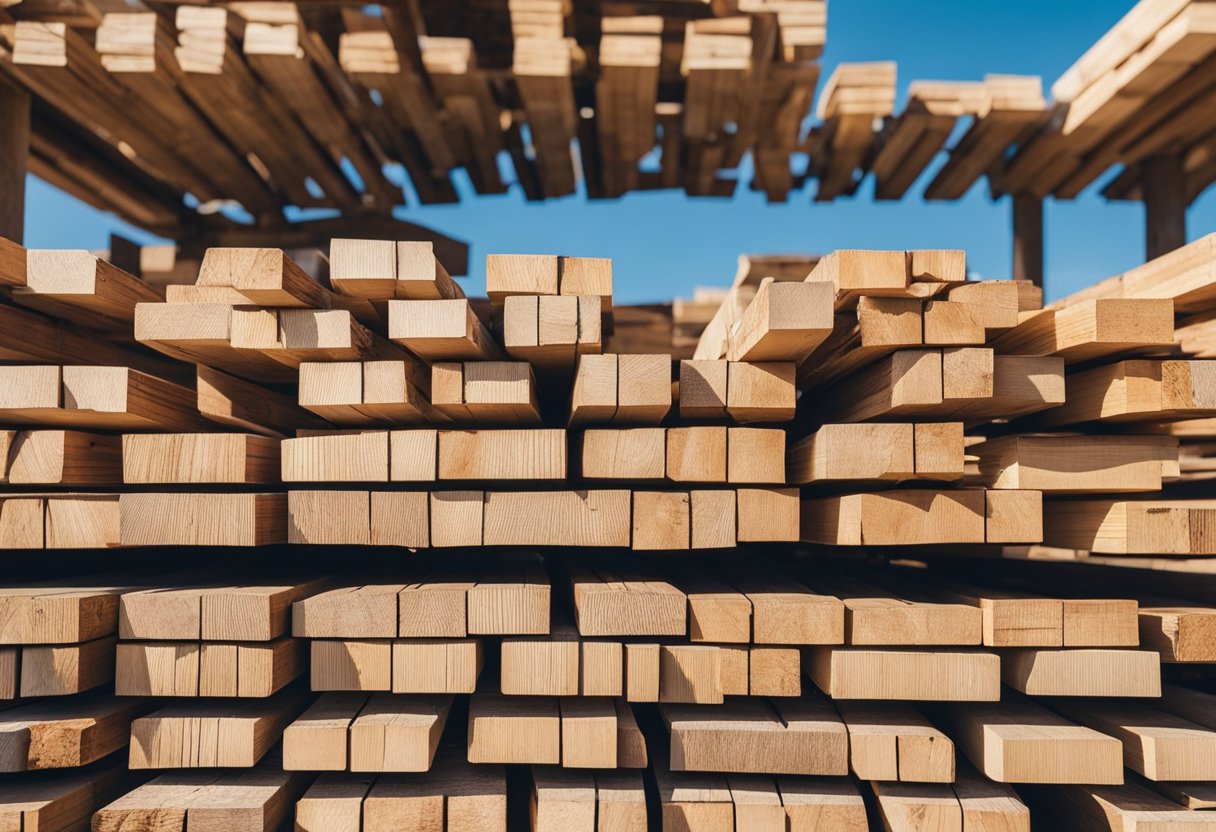As a woodworking enthusiast, I know the importance of using pressure-treated wood for outdoor projects. However, pressure-treated wood contains moisture, which can lead to warping, cracking, and decay over time. That’s why it’s crucial to dry pressure-treated wood properly before using it in any outdoor structure or furniture.
Understanding pressure-treated wood is the first step in learning how to dry it. Pressure-treated wood is lumber that has been treated with preservatives to resist rot, decay, and insect damage. The preservatives penetrate the wood cells, making it resistant to environmental conditions that would otherwise cause it to deteriorate. However, the preservatives also make the wood heavier and wetter than untreated wood, which is why it needs to be dried properly before use.
Key Takeaways
- Pressure-treated wood is lumber treated with preservatives to resist rot, decay, and insect damage.
- Properly drying pressure-treated wood is crucial to prevent warping, cracking, and decay over time.
- Methods of drying pressure-treated wood include air-drying, kiln-drying, and using a dehumidifying kiln.
Understanding Pressure Treated Wood
As a woodworker, it is essential to understand the properties of pressure-treated wood. Pressure-treated wood is lumber that has been treated with chemical preservatives to protect it from rot, decay, and insects. This type of wood is commonly used for outdoor projects such as fences, furniture, picnic tables, and other outdoor structures.
Pressure-treated wood is made from softwood and hardwood. Softwood, like pine or spruce, dries faster than hardwood, like oak or maple, because of its porous nature. The method of treatment used on the wood will also affect its drying time. For instance, the time for pressure-treated lumber to dry is longer than untreated wood because of the chemicals.
The chemicals used to treat pressure-treated wood are designed to resist rot, decay, and insects. The most common chemical preservatives used in pressure-treated wood are chromated copper arsenate (CCA), alkaline copper quaternary (ACQ), and copper azole (CA). CCA is no longer used in residential settings due to its toxicity, but it is still used for industrial purposes.
When working with pressure-treated wood, it is important to note that it is not suitable for ground contact. The chemicals used in the treatment process can leach into the soil, which can be harmful to plants and animals. Therefore, it is essential to use alternative materials for ground contact, such as brick, stone, or concrete.
In summary, pressure-treated wood is an excellent choice for outdoor projects due to its resistance to rot, decay, and insects. However, it is essential to understand the properties of pressure-treated wood and the chemicals used in its treatment to ensure that it is used safely and effectively.
The Importance of Drying Pressure Treated Wood
https://www.youtube.com/watch?v=F9A3i0OhU3g&embed=true
As a woodworker, I know that pressure-treated wood is a popular choice for outdoor projects due to its resistance to rot, insects, and decay. However, it is important to remember that wet pressure-treated lumber can cause problems if not properly dried before use.
The drying process is critical to ensure that the wood maintains its dimensional stability and does not shrink or warp after installation. Moisture is a major factor in the rot and decay of wood, and drying pressure-treated wood is essential to prevent these issues from occurring.
There are several methods to dry pressure-treated wood, including using a wood kiln, air-drying, and using a moisture meter to determine the moisture level of the wood. Kiln-dried after treatment (KDAT) wood is a popular option for those who want to ensure that their wood is properly dried before use.
It is important to note that unseasoned wood takes a long time to dry, and it can take more than five months to dry properly. Building with wet pressure-treated lumber can cause problems down the line, so it is essential to ensure that the wood is properly dried before use.
In summary, drying pressure-treated wood is critical to ensure that the wood maintains its dimensional stability and does not shrink or warp after installation. Moisture is a major factor in the rot and decay of wood, and drying pressure-treated wood is essential to prevent these issues from occurring.
Methods of Drying Pressure Treated Wood
https://www.youtube.com/watch?v=qwZ-apBYtIc&embed=true
As a woodworker, it is important to know how to dry pressure treated wood. When wood is treated with chemicals, it becomes difficult to dry because of its high moisture content. But, there are different methods to dry pressure treated wood, and each of these methods has its own advantages and disadvantages. In this section, I will discuss the two most common methods of drying pressure treated wood.
Air-Drying Method
Air-drying is the most common method of drying pressure treated wood. It is a simple process that involves stacking the wood in a criss-cross pattern and allowing it to dry naturally. This process can take up to several weeks or even months, depending on the humidity and temperature of the environment.
To speed up the drying process, it is important to stack the wood in a way that allows for good air circulation. If stacked incorrectly, the wood may warp or crack. Therefore, it is important to stack the wood in a way that allows for good air circulation.
Kiln-Drying Method
Kiln-drying is a faster method of drying pressure treated wood. This method involves using a dehumidifier or a wood kiln to dry out the wood. Kiln-drying can take up to several days or a few weeks, depending on the thickness and moisture content of the wood.
One advantage of kiln-drying is that it can help to reduce the moisture content of the wood to a level that is suitable for indoor use. However, kiln-drying can also cause the wood to shrink and crack if not done properly. Therefore, it is important to monitor the drying process closely to ensure that the wood is not over-dried.
In conclusion, both air-drying and kiln-drying are effective methods of drying pressure treated wood. However, each method has its own advantages and disadvantages. It is important to choose the method that is best suited for your particular project.
Preventing Warping and Cracking
https://www.youtube.com/watch?v=GAyKMotQBDw&embed=true
When it comes to drying pressure treated wood, preventing warping and cracking is crucial. If the wood is not dried properly, it can warp, crack, or even shrink. This can lead to structural problems and even safety hazards. Here are some tips to prevent warping and cracking:
1. Use a Dehumidifying Kiln
One of the best ways to dry pressure treated wood without warping or cracking is to use a dehumidifying kiln. This method removes moisture from the wood while controlling the humidity levels, which reduces the risk of warping or cracking. However, be careful not to dry out the wood to the point of cracking.
2. Air-Dry the Wood
Another option is to air-dry the pressure treated wood. Stack the wood in a criss-cross pattern to allow it to air-dry. This is best done during warm, low humidity weather. Make sure to keep the wood off the ground and cover it with a tarp to protect it from rain.
3. Seal the Wood
Sealing the wood with a water-repellent sealer is another effective way to prevent warping and cracking. This helps to keep the moisture out of the wood and reduce the risk of checks. Make sure to apply the sealer to all sides of the wood.
4. Use KDAT Wood
Kiln-dried after treatment (KDAT) wood is another option to prevent warping and cracking. This type of wood is dried in a kiln after it has been pressure treated, which removes excess moisture and reduces the risk of warping or cracking.
5. Check the Moisture Content
Before you start the drying process, make sure to check the moisture content of the wood. The wood should have a moisture content of around 15% before it is dried. If the wood is too wet, it can warp or crack during the drying process.
By following these tips, you can prevent warping and cracking when drying pressure treated wood. Remember to always check the moisture content of the wood and choose the right drying method for your project.
Painting and Staining Pressure Treated Wood
https://www.youtube.com/watch?v=n9qkt3diWj8&embed=true
When it comes to painting or staining pressure treated wood, it’s important to wait until the wood is completely dry. Wet pressure treated lumber can take several months to dry out naturally, but there are a few ways to speed up the process.
One option is to use a wood kiln, which can dry out the wood quickly without warping or cracking it. Another option is to stack the pressure-treated wood in a criss-cross pattern and allow it to air-dry during warm, low humidity weather.
Once the pressure treated wood is dry, it’s important to test the moisture content before painting or staining. A moisture meter can be used to determine if the wood is ready to be sealed.
When selecting a stain or paint, it’s important to choose a product that is designed for exterior use. Oil-based stains and latex stains are both suitable for staining pressure treated wood. Any stain that is designed for exterior use will work to stain pressure treated wood.
Before applying the stain or paint, it’s important to clean the surface of the wood and patch any areas that need attention. Priming the wood before painting is also recommended.
It’s important to note that even pressure treated wood is vulnerable to moisture and ultraviolet light, so sealing the wood with a stain or paint is necessary to protect it and give it a longer life.
Use Cases of Dried Pressure Treated Wood
As a woodworking enthusiast, I know that dried pressure treated wood is a versatile material that can be used in a variety of projects. Here are some common use cases where dried pressure treated wood can be a great option:
Decks and Fences
Decks and fences are some of the most common outdoor projects that require pressure treated wood. Dried pressure treated wood is a great option for these projects as it is resistant to rot, decay, and insect damage. It also has a long lifespan, meaning that it will last for many years with minimal maintenance.
Furniture
Dried pressure treated wood can be a great option for outdoor furniture. It is durable and resistant to the elements, making it a great choice for chairs, benches, and tables that will be exposed to rain, sun, and wind. It can also be used for indoor furniture, especially in areas that are prone to moisture, such as basements or bathrooms.
Ventilation and Outdoor Projects
Dried pressure treated wood is also a great option for outdoor projects that require ventilation, such as sheds, playhouses, and dog houses. Its resistance to moisture and decay makes it a great choice for these types of projects, which are often exposed to the elements.
Softwood and Hardwood
Dried pressure treated wood is available in both softwood and hardwood varieties. Softwood, such as pine, is a great option for projects that require a more affordable material, while hardwood, such as oak or cedar, is a great option for projects that require a more durable and long-lasting material.
Construction Projects
Dried pressure treated wood is also commonly used in construction projects, such as framing and flooring. Its resistance to moisture and decay makes it a great choice for these types of projects, which are often exposed to the elements.
Picnic Tables
Finally, picnic tables are another great use case for dried pressure treated wood. Its durability and resistance to the elements make it a great choice for outdoor picnic tables that will be exposed to rain, sun, and wind.
Overall, dried pressure treated wood is a versatile material that can be used in a variety of projects. Whether you are working on a construction project, building outdoor furniture, or constructing a deck or fence, dried pressure treated wood is a great option that will provide durability and resistance to the elements.
Conclusion
Drying pressure-treated wood is an important step to ensure its longevity and durability. Moisture is the main culprit behind rot, decay, and insect damage in outdoor structures, furniture, fences, and other construction projects made of pressure-treated wood. Therefore, it is crucial to dry the wood properly before using it.
There are several methods to dry pressure-treated wood, including air-drying, kiln-drying, using a fan, and using a wood-drying cabinet. The drying process depends on several factors, such as the moisture level of the wood, the environmental conditions, and the type of wood (softwood or hardwood). It is essential to monitor the moisture content of the wood using a moisture meter to prevent cracking, checks, and dimensional instability.
To speed up the drying process, you can use a dehumidifier or fans to increase airflow around the wood. However, be careful not to expose the wood to direct sunlight or extreme heat, as this can cause rapid drying and potential cracking.
It is also important to note that wet pressure-treated lumber should not be used for ground contact or aluminum applications. In addition, CCA (chromated copper arsenate) chemical preservatives are no longer used in pressure-treated wood due to health and environmental concerns.
In conclusion, drying pressure-treated wood is an essential step to ensure its resistance to rot, decay, and insect damage. By using the right method and monitoring the moisture content, you can increase the longevity and durability of your pressure-treated wood projects.
Frequently Asked Questions
https://www.youtube.com/watch?v=FLbc8Jx1nXY&embed=true
How long should I wait before staining pressure-treated wood?
You should wait at least 6 months before staining pressure-treated wood. This will give the wood enough time to dry out and allow the chemicals to settle. If you stain the wood too soon, the stain may not adhere properly, and the wood may not look as good as it should.
Can I build with pressure-treated wood that’s still wet?
It is not recommended to build with pressure-treated wood that is still wet. Wet wood is more susceptible to warping, twisting, and cracking as it dries. It is best to wait until the wood is completely dry before using it for any construction projects.
How long does it take for pressure-treated wood to dry?
The drying time for pressure-treated wood depends on several factors, including the type of wood, the thickness of the wood, and the humidity and temperature of the environment. On average, it can take several weeks to several months for pressure-treated wood to dry completely.
Does pressure-treated wood shrink when it dries?
Yes, pressure-treated wood can shrink as it dries. This is because the moisture content in the wood decreases as it dries, causing the wood to shrink in size. The amount of shrinkage will vary depending on the type of wood and the drying conditions.
What happens if pressure-treated wood gets wet?
If pressure-treated wood gets wet, it can cause the wood to swell, warp, and crack. Wet wood is also more susceptible to rot and decay, which can compromise the structural integrity of the wood.
Will pressure-treated wood warp as it dries?
Pressure-treated wood can warp as it dries, especially if it is not dried properly. To prevent warping, it is important to stack the wood properly and allow for proper air circulation during the drying process.

Hi, I’m Sal Muller of Tooltrip.com. My DIY experience led me to understand essential power tools for home projects. Tooltrip.com guides enthusiasts and professionals in choosing right tools for any job. I provide concise top tool reviews for easier, efficient DIY.





